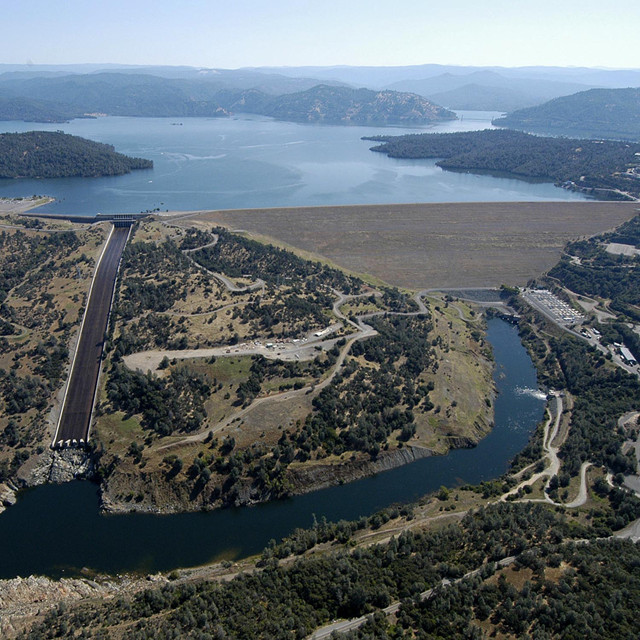
by Fred Schwab Monday, December 11, 2017

Oroville Dam and Lake Oroville reservoir from the air, within the Lake Oroville State Recreation Area, northern California. Credit: public domain.
Catastrophic dam failures make news. The worst in U.S. history, the Johnstown Flood of 1889 in Pennsylvania, killed more than 2,200 people and produced more than $450 million in damage (in present-day dollars). Just last February, a potential catastrophe — thankfully averted — engulfed national news as the Oroville Dam in Northern California threatened to breach. The threat alone forced almost 200,000 people to evacuate from areas downstream that would’ve been flooded had the dam broken. As the Oroville reservoir filled during record-breaking rains, attempts to lower water levels in the reservoir relied partly on a poorly maintained emergency spillway that eventually gave way, threatening to breach the whole dam. The episode highlighted persistent issues with dam maintenance.
The United States has more than 90,000 dams, with an average age of 50 years. As engineering practices have improved, older dams have increasingly become outdated in terms of design, construction and placement. Nearly 2,000 dams considered “high hazard” were designated “in need of repair” in 2015, according to the Association of State Dam Safety Officials. Books could be written about issues related to maintenance alone. But dam placement is also critical — and, fortunately (or unfortunately?), we’ve learned a whole lot about the vulnerabilities of some dam sites since they were erected.
For example, the Hetch Hetchy system in California provides San Francisco with much of its water. One component, the O’Shaughnessy Dam, stores 25 percent of the water in this system. It was built in 1923 by the city, flooding the Hetch Hetchy Valley along a portion of the Tuolumne River within Yosemite National Park. Prior to being submerged, the valley rivaled the beauty of Yosemite Valley. Its loss awakened the public to the importance of preserving nature, and a campaign to raze the O’Shaughnessy (and restore the Hetch Hetchy Valley) was a ballot issue for San Francisco voters in 2012. It failed, but similar efforts continue. One of the big concerns about the Hetch Hetchy system today is that several of the reservoirs lie directly on or very near significant faults. Two of the reservoirs, the Calaveras and San Antonio, built in 1925 and 1964, respectively, lie just above the city of Fremont and are less than 11 kilometers from the Hayward Fault. The dams impounding these reservoirs are considered extremely seismically vulnerable — in fact, a replacement dam for the Calaveras is currently under construction. But what about other dams in distress?
Around the world, some dam problems are even worse. In Iraq, politics played a decisive role for the siting of the Mosul Dam in Iraq — an immense 125-meter-tall barrier that regulates the Tigris River and protects millions of Iraqis downstream from floodwaters — despite warnings from scientists and engineers about its geologic setting.
Mosul Dam rests on stratified anhydrite, marl, limestone and gypsum, which dissolve relatively easily in water. Progressive karstification has riddled the dam’s foundation with growing voids and sinkholes that allow reservoir water to seep beneath and past the dam. To counter this, engineers have pumped roughly 100,000 tons of cement grout into the cavities since 1984, although that ceased when the militant Islamic group ISIS captured and briefly held the dam in 2014. Workers then fled and much of the maintenance equipment was destroyed. During that period of neglect, which lasted between four months and a year, an additional 23,000 cubic meters of empty voids (roughly the volume of the White House) developed right beneath the dam. By 2015, the entire dam was found to be fragmenting, tilting and sinking, and water from the reservoir was “piping” through the voids — a precursor to large-scale collapse.
In 1988, Saddam Hussein agreed to build the Badush Dam downstream from the Mosul Dam, mainly to protect the lower Tigris Valley if the unstable Mosul Dam failed. But sanctions imposed on Iraq halted construction of the Badush in 1991. It remains incomplete. The U.S. Army Corps of Engineers in 2016 concluded that Mosul Dam is “the most dangerous dam in the world.” An Italian company has been contracted to shore up the dam, but experts agree that no matter how much shoring up is done, it’s only a matter of time before it fails. And when it fails, it could drown more than a million people and leave another 4 million people homeless. Much of Iraq would be without power for weeks or months.
These selective dam histories are instructive for current and future dam projects: Heed the expertise of geologists and engineers. Maintain dam infrastructure. Keep the public in the know. And be damn sure you know where you’re building in the first place.
© 2008-2021. All rights reserved. Any copying, redistribution or retransmission of any of the contents of this service without the expressed written permission of the American Geosciences Institute is expressly prohibited. Click here for all copyright requests.